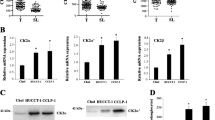Abstract
To investigate the expressions of casein kinase II β(CK2β) and X-Linked inhibitor of apoptosis protein (XIAP) in cholangiocarcinoma (CCA) and evaluated their correlations with major clinicopathologic features and patients’ survival. Fifty CCA specimens and 20 normal liver tissues were included in the study. Immunohistochemical staining was used to determine the expression levels of CK2β, XIAP in normal and CCA tissues. The relationships of CK2β and XIAP expressions with clinicopathologic parameters and clinical outcome were evaluated. High immunostaining of CK2β and XIAP were observed in 66 % (33/50) and 68 % (34/50) of CCA tissues, which were significantly higher than that of normal liver tissues 0 % (0/20) and 25 % (5/20). The high expression of CK2β was significantly associated with TNM stage (P = 0.036), histological grade (P = 0.020) and high serum CEA level(P = 0.010), while high expression of XIAP was only associated with TNM stage(P = 0.014) and high serum CEA level(P = 0.001). By univariant analysis, patients with high expression of CK2β and XIAP demonstrate significantly poorer overall survival (P = 0.003 vs P = 0.018). Cox regression model showed that positive expression of CK2βis an independent factor of prognosis (P = 0.004). The expressions of CK2β and XIAP in CCA tissues showed strong correlations with the tumor progression, CK2β may be applied as a potential prognostic marker for CCA.



Similar content being viewed by others
References
Blechacz B, Gores GJ (2008) Cholangiocarcinoma: advances in pathogenesis, diagnosis, and treatment. Hepatology 48:308–321. doi:10.1002/hep.22310
Hsing AW, Gao YT, Han TQ et al (2007) Gallstones and the risk of biliary tract cancer: a population-based study in China. Br J Cancer 97:1577–1582. doi:10.1038/sj.bjc.6604047
Shaib YH, Davila JA, McGlynn K et al (2004) Rising incidence of intrahepatic cholangiocarcinoma in the United States: a true increase? J Hepatol 40:472–477. doi:10.1016/j.jhep.2003.11.030
Patel T (2001) Increasing incidence and mortality of primary intrahepatic cholangiocarcinoma in the United States. Hepatology 33:1353–1357. doi:10.1053/jhep. 2001.25087
Zhang P, Davis AT, Ahmed K (1998) Mechanism of protein kinase CK2 association with nuclear matrix: role of disulfide bond formation. J Cell Biochem 69:211–220
Graham KC, Litchfield DW (2000) The regulatory β subunit of protein kinase CK2 mediates formation of tetrameric CK2 complexes. J Biol Chem 275:5003–5010
Ahmed K (1999) Nuclear matrix and protein kinase CK2 signaling. Crit Rev Eukaryot Gene Expr 9:329–336
Tawfic S, Faust RA, Gapany M et al (1996) Nuclear matrix as an anchor for protein kinase CK2 nuclear signalling. J Cell Biochem 62:165–171
Guo C, Yu S, Davis AT et al (2001) A potential role of nuclear matrix-associated protein kinase CK2 in protection against drug-induced apoptosis in cancer cells. J Biol Chem 276:5992–5999. doi:10.1074/jbc.M004862200
Ahmad KA, Wang G, Unger G et al (2008) Protein Kinase CK2 - A key suppressor of apoptosis. Adv Enzyme Regul 48:179–187. doi:10.1016/j.advenzreg.2008.04.002
Wang G, Ahmad KA, Ahmed K (2006) Role of Protein kinase CK2 in the regulation of tumor necrosis factor–related apoptosis inducing ligand–induced apoptosis in prostate cancer cells. Cancer Res 66:2242–2249. doi:10.1158/0008-5472.CAN-05-2772
Hamacher R, Saur D, Fritsch R et al (2007) Casein kinase II inhibition induces apoptosis in pancreatic cancer cells. Oncol Rep 18:695–701
Wang G, Ahmad KA, Ahmed K (2005) Modulation of receptor mediated apoptosis by CK2. Mol Cell Biochem 274:201–205
Wang G, Unger G, Ahmad KA et al (2005) Downregulation of CK2 induces apoptosis in cancer cells-a potential approach to cancer therapy. Mol Cell Biochem 274:77–84
Wang G, Ahmad KA, Harris NH et al (2008) Impact of protein kinase CK2 on inhibitor of apoptosis proteins in prostate cancer cells. Mol Cell Biochem 316:91–97. doi:10.1007/s11010-008-9810-9
Ishak KG, Anthony PP, Sobin LH (1994) Nonepithelial tumors. In: Ishak KG (ed) World Health Organization International Classification of Tumors. Springer, Berlin, pp 22–27
Wittekind C (2006) Pitfalls in the classification of liver tumors. Pathology 27:289–293. doi:10.1007/s00292-006-0834-1
Liu YF, Zhao R, Guo S et al (2011) Expression and clinical significance of hepatoma-derived growth factor as a prognostic factor in human hilar cholangiocarcinoma. Ann Surg Oncol 18:872–879. doi:10.1245/s10434-010-1303-x
Lin KY, Fang CL, Chen Y et al (2010) Overexpression of nuclear protein kinase CK2β subunit and prognosis in human gastric carcinoma. Ann Surg Oncol 17:1695–1702. doi:10.1245/s10434-010-0911-9
Laramas M, Pasquier D, Filhol O et al (2007) Nuclear localization of protein kinase CK2 catalytic subunit (CK2α) is associated with poor prognostic factors in human prostate cancer. Eur J Cancer 43:928–934. doi:10.1016/j.ejca.2006.11.021
Zhao M, Ma J, Zhu HY et al (2011) Apigenin inhibits proliferation and induces apoptosis in human multiple myeloma cells through targeting the trinity of CK2, Cdc37 and Hsp90. Mol Cancer 10:104. doi:10.1186/1476-4598-10-104
Huang XY, Ke AW, Shi GM et al (2010) Overexpression of CD151 as an adverse marker for intrahepatic cholangiocarcinoma patients. Cancer 16:5440–5451. doi:10.1002/cncr. 25485
Boonjaraspinyo S, Boonmars T, Kaewkes S et al (2012) Down-regulated expression of HSP70 in correlation with clinicopathology of cholangiocarcinoma. Pathol Oncol Res 18:227–237. doi:10.1007/s12253-011-9432-5
Yuan RH, Jeng YM, Hu RH et al (2011) Role of p53 and β-catenin mutations in conjunction with CK19 expression on early tumor recurrence and prognosis of hepatocellular carcinoma. J Gastrointest Surg 15:321–329. doi:10.1007/s11605-010-1373-x
Acknowledgments
The authors have no financial interest in any product or concept discussed in article. This work is supported by the Foundation of Science and Technology Department of Zhejiang Province, China (no. 2011C13034-2) and the National Natural Science Foundation of China (no. 81272671).
Author information
Authors and Affiliations
Corresponding author
Rights and permissions
About this article
Cite this article
Zhou, F., Xu, J., Ding, G. et al. Overexpressions of CK2β and XIAP are Associated with Poor Prognosis of Patients with Cholangiocarcinoma. Pathol. Oncol. Res. 20, 73–79 (2014). https://doi.org/10.1007/s12253-013-9660-y
Received:
Accepted:
Published:
Issue Date:
DOI: https://doi.org/10.1007/s12253-013-9660-y




